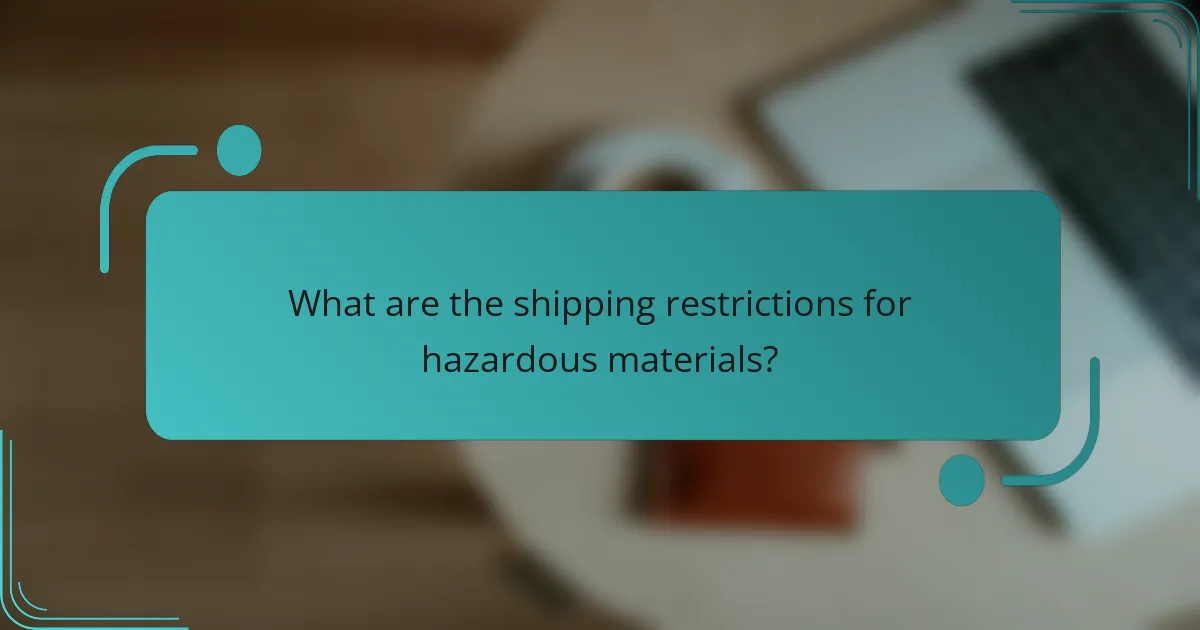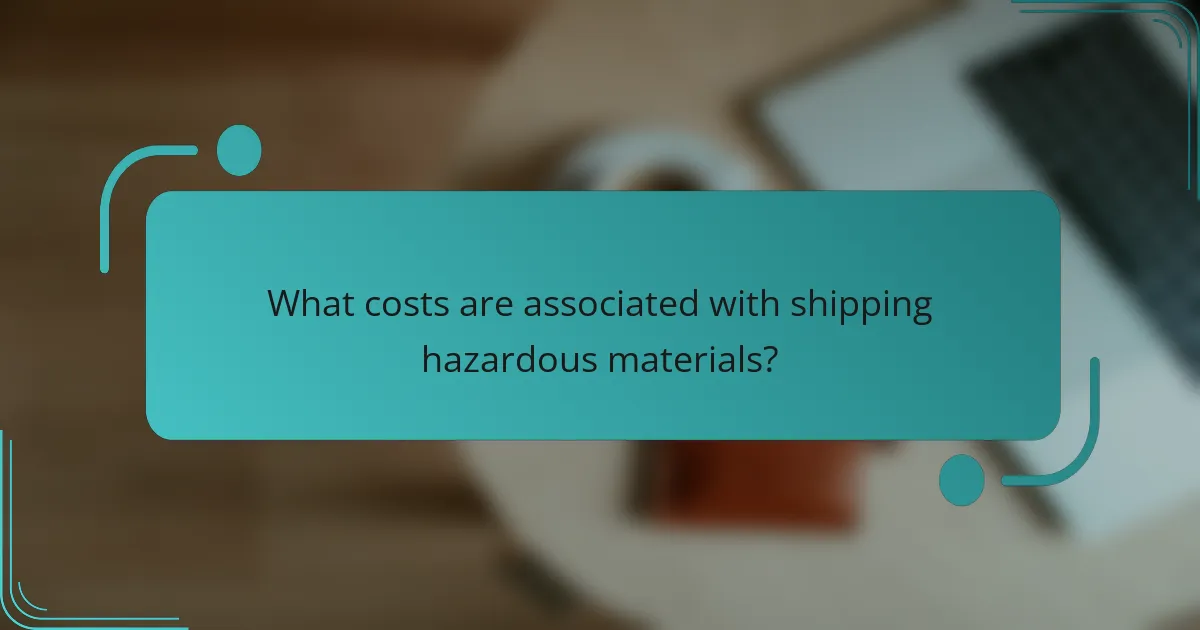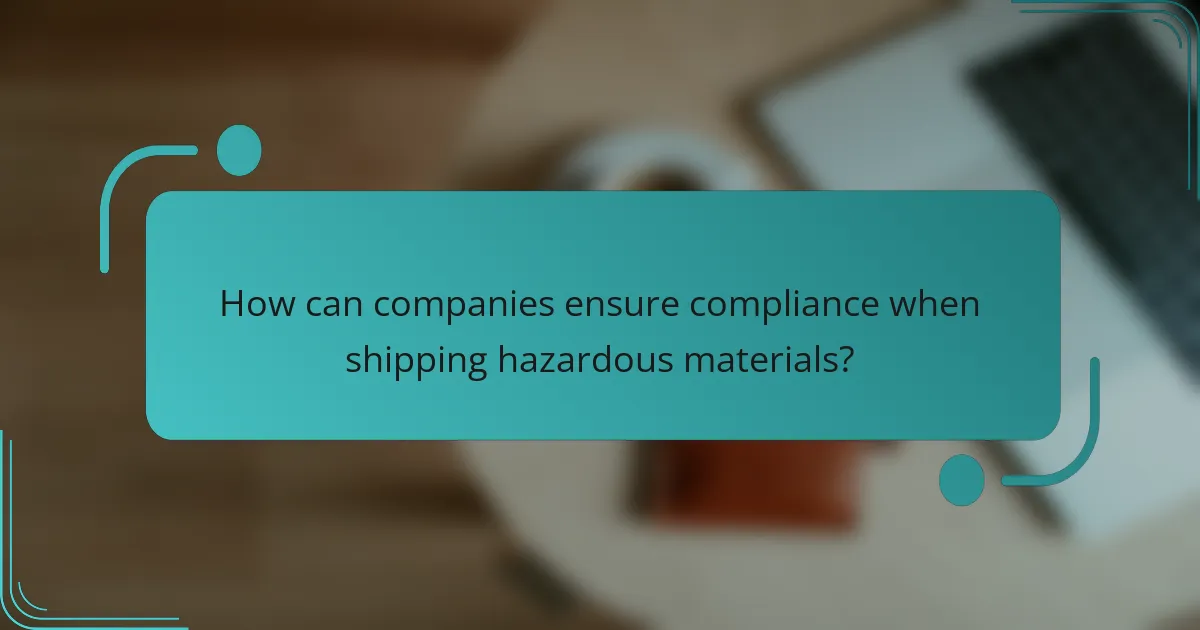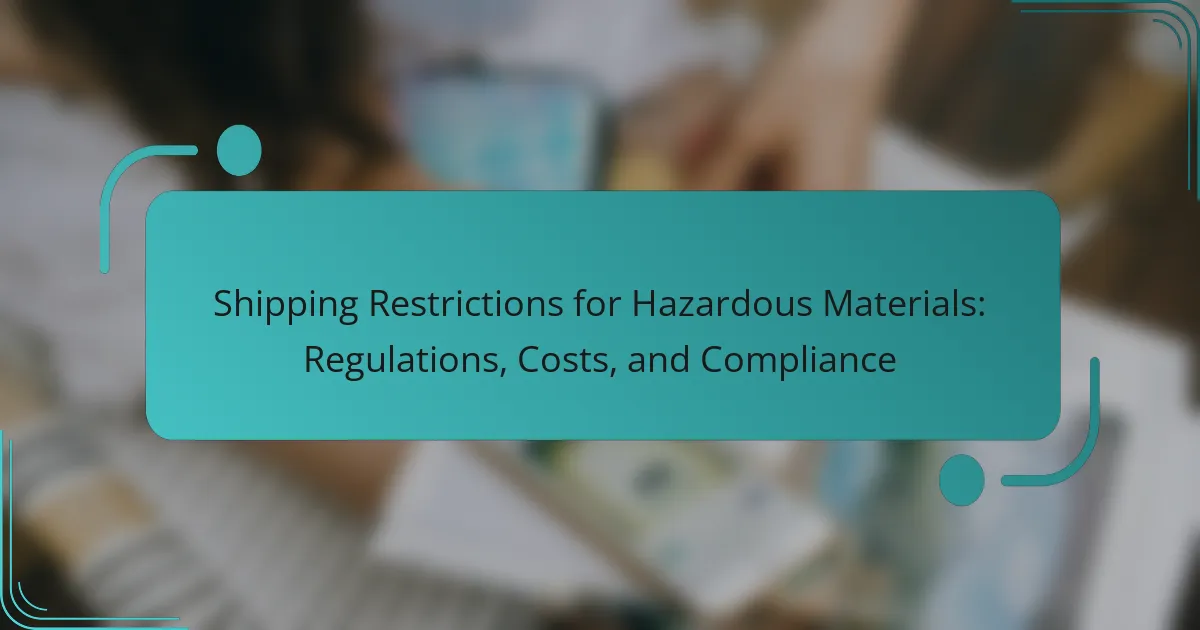
What are the shipping restrictions for hazardous materials?
Shipping restrictions for hazardous materials are governed by various regulations. These regulations include the U.S. Department of Transportation (DOT) and the International Air Transport Association (IATA) guidelines. Hazardous materials must be classified based on their properties, such as flammability or toxicity. Specific packaging requirements must be met to ensure safety during transport. Labeling and documentation are also mandatory for hazardous materials shipments. Non-compliance with these regulations can result in fines and legal repercussions. It is essential for shippers to stay informed about changes in regulations to maintain compliance.
How are hazardous materials classified for shipping purposes?
Hazardous materials are classified for shipping purposes based on their physical and chemical properties. The classification system includes categories such as flammable, toxic, corrosive, and radioactive materials. Each category has specific regulations governing their transportation. The United Nations (UN) assigns a unique identification number to each hazardous material. This number helps in identifying the material and ensuring proper handling. Additionally, the materials are grouped into classes, such as Class 1 for explosives and Class 2 for gases. The classification process also considers the potential risks associated with each material during transport. These classifications help to ensure safety and compliance with international regulations.
What criteria determine the classification of hazardous materials?
Hazardous materials are classified based on their physical, chemical, and biological properties. These criteria include flammability, toxicity, reactivity, and environmental impact. Flammability assesses the material’s ability to ignite and sustain combustion. Toxicity evaluates the potential harm to health upon exposure. Reactivity measures how the material interacts with other substances. Environmental impact considers the potential harm to ecosystems. The United Nations and regulatory bodies provide guidelines for these classifications. These criteria are essential for ensuring safe handling and transportation of hazardous materials.
Why is proper classification essential for shipping hazardous materials?
Proper classification is essential for shipping hazardous materials to ensure safety and compliance with regulations. Accurate classification helps identify the specific risks associated with each material. This allows for the implementation of appropriate handling and packaging measures. Additionally, it facilitates the correct labeling and documentation required by regulatory bodies. Misclassification can lead to dangerous situations, including accidents and environmental harm. Regulations, such as those from the U.S. Department of Transportation, mandate proper classification to protect public safety. Non-compliance can result in severe penalties and legal repercussions for shippers.
What regulations govern the shipping of hazardous materials?
The shipping of hazardous materials is governed by several key regulations. In the United States, the Department of Transportation (DOT) enforces the Hazardous Materials Regulations (HMR). These regulations are outlined in Title 49 of the Code of Federal Regulations (CFR). The HMR establishes requirements for the classification, packaging, marking, labeling, and documentation of hazardous materials. Internationally, the International Air Transport Association (IATA) and the International Maritime Organization (IMO) set standards for air and sea transport, respectively. Compliance with these regulations is crucial to ensure safety and prevent environmental harm during transportation.
Which organizations set the regulations for hazardous materials shipping?
The organizations that set the regulations for hazardous materials shipping include the U.S. Department of Transportation (DOT), the International Air Transport Association (IATA), and the International Maritime Organization (IMO). The DOT oversees the Hazardous Materials Regulations (HMR) in the United States. IATA provides guidelines for the safe transport of dangerous goods by air. The IMO establishes the International Maritime Dangerous Goods (IMDG) Code for maritime shipping. These organizations ensure safety and compliance in the transportation of hazardous materials across various modes of transport.
How do international regulations differ from national regulations?
International regulations govern shipping on a global scale, while national regulations apply within a specific country. International regulations, such as those from the International Maritime Organization (IMO), establish uniform standards for hazardous materials transport across borders. National regulations can vary significantly, reflecting local laws and safety standards. For example, the U.S. Department of Transportation (DOT) has its own set of rules that may differ from those set by the European Union. These differences can affect packaging, labeling, and documentation requirements. Compliance with international regulations often requires adherence to treaties and conventions that facilitate international trade. In contrast, national regulations may prioritize local environmental and safety concerns. Thus, entities must navigate both sets of regulations to ensure compliance in global shipping operations.
What are the penalties for non-compliance with hazardous materials shipping regulations?
Penalties for non-compliance with hazardous materials shipping regulations can include significant fines and legal repercussions. The U.S. Department of Transportation (DOT) can impose civil penalties ranging from $250 to $75,000 per violation. Criminal penalties can also apply, leading to imprisonment for up to five years for willful violations. Additionally, companies may face reputational damage and increased scrutiny from regulatory agencies. Compliance with regulations is vital to avoid these severe consequences.
What are the potential legal consequences of non-compliance?
Potential legal consequences of non-compliance with shipping restrictions for hazardous materials include fines, penalties, and criminal charges. Regulatory agencies can impose significant monetary fines for violations. For example, the Environmental Protection Agency (EPA) can levy fines up to $37,500 per day per violation. Companies may also face civil lawsuits from affected parties. Non-compliance can result in the suspension or revocation of shipping permits. Additionally, individuals responsible for violations may face criminal charges, leading to imprisonment. These consequences underscore the importance of adhering to regulations governing hazardous materials shipping.
How can companies mitigate the risks of non-compliance?
Companies can mitigate the risks of non-compliance by implementing robust compliance programs. These programs should include regular training for employees on regulations related to hazardous materials. Companies must conduct thorough audits to identify compliance gaps. Utilizing compliance management software can streamline adherence to regulations. Establishing clear communication channels for reporting non-compliance issues is essential. Collaborating with legal experts ensures that companies stay updated on regulatory changes. Maintaining accurate documentation of all shipping activities is crucial for accountability. Research indicates that organizations with strong compliance frameworks reduce the likelihood of penalties by up to 30%.

What costs are associated with shipping hazardous materials?
Costs associated with shipping hazardous materials include packaging, labeling, and transportation fees. Packaging costs are higher due to the need for specialized containers. Labeling requirements also incur additional expenses for compliance with regulations. Transportation fees may increase based on the carrier’s policies regarding hazardous materials. Insurance costs can be elevated due to the risks involved in shipping such items. Regulatory compliance costs arise from the need to adhere to safety standards. These costs can vary significantly depending on the type of hazardous material and the shipping distance. Overall, shipping hazardous materials involves multiple layers of expenses that ensure safety and compliance.
How do shipping costs for hazardous materials compare to non-hazardous materials?
Shipping costs for hazardous materials are generally higher than for non-hazardous materials. This increase is due to the additional regulations and safety measures required for transporting hazardous materials. Specialized packaging, labeling, and handling procedures contribute to the higher costs. For instance, the U.S. Department of Transportation mandates specific packaging standards for hazardous materials. Compliance with these regulations often requires more expensive materials and processes. Furthermore, carriers may charge additional fees for the risk associated with transporting hazardous items. Non-hazardous materials do not incur these extra costs, making their shipping more economical.
What factors influence the shipping costs of hazardous materials?
Shipping costs of hazardous materials are influenced by several key factors. These factors include regulatory compliance requirements. Shipping hazardous materials requires adherence to strict regulations set by agencies such as the Department of Transportation (DOT) and the International Air Transport Association (IATA). These regulations can increase shipping costs due to necessary documentation and training.
Another factor is the mode of transportation. Different modes, such as air, sea, or ground, have varying costs associated with them. Air transport is generally more expensive due to speed and safety measures. Additionally, the distance of the shipment impacts costs. Longer distances typically incur higher shipping fees.
The type of hazardous material also plays a significant role. Materials classified as more dangerous, like explosives or toxic substances, often require special handling and packaging. This can increase costs significantly. Insurance requirements are another factor. Higher risks associated with hazardous materials lead to increased insurance premiums.
Finally, the packaging and labeling of hazardous materials can affect shipping costs. Specialized packaging is often required, which can be more expensive than standard packaging. Overall, these factors collectively determine the shipping costs for hazardous materials.
Are there additional fees for special handling of hazardous materials?
Yes, there are additional fees for special handling of hazardous materials. These fees cover the extra precautions required for safety and compliance. The U.S. Department of Transportation mandates specific handling procedures for hazardous materials. Compliance with these regulations often incurs extra costs. These costs can vary based on the type of hazardous material and shipping method. For example, air transportation typically has higher fees than ground shipping. Companies must account for these fees in their shipping budgets. Overall, special handling fees are a necessary component of hazardous material shipping.
What are the costs of compliance with hazardous materials shipping regulations?
The costs of compliance with hazardous materials shipping regulations include various fees and expenses. These can range from training costs for employees to ensure proper handling and shipping. Companies may also incur expenses for packaging materials that meet regulatory standards. Additionally, there are costs associated with obtaining necessary permits and conducting safety audits.
Insurance premiums may increase due to the higher risks involved in shipping hazardous materials. Fines and penalties can arise from non-compliance with regulations, adding to overall costs. According to the U.S. Department of Transportation, compliance can cost businesses thousands to millions of dollars annually, depending on the volume and type of materials shipped.
What training and certification expenses are involved?
Training and certification expenses for shipping hazardous materials typically include course fees, materials, and examination costs. Course fees can range from $200 to $1,500 depending on the provider and course length. Additionally, training materials may cost around $50 to $200. Certification exams often have fees between $100 and $300. Companies may also incur costs for employee time spent in training, which can vary based on hourly wages. These expenses are necessary to comply with regulations set by agencies like the Department of Transportation and the Environmental Protection Agency. Compliance with these regulations is crucial for safe and legal shipping practices.
How can companies budget for compliance costs effectively?
Companies can budget for compliance costs effectively by conducting a thorough risk assessment. This assessment identifies potential compliance-related expenses associated with shipping hazardous materials. Companies should also analyze historical data on compliance costs to forecast future expenses accurately. Allocating a specific percentage of the overall budget for compliance can help manage these costs. Regularly reviewing and adjusting the budget based on changing regulations is essential. Furthermore, investing in training and compliance software can reduce long-term costs. According to a survey by the Compliance, Governance and Oversight Council, companies that implement proactive compliance measures save an average of 20% on related costs.
What financial implications arise from shipping delays or incidents involving hazardous materials?
Shipping delays or incidents involving hazardous materials can lead to significant financial implications. These implications include increased shipping costs due to rerouting or expedited shipping methods. Companies may face fines for regulatory non-compliance, which can range from thousands to millions of dollars. Additionally, delays can result in lost sales and revenue due to unfulfilled customer orders.
Insurance claims may increase, leading to higher premiums in the future. The cost of cleanup and liability from hazardous material incidents can be substantial. According to the EPA, cleanup costs can exceed $1 million depending on the incident’s severity. Furthermore, reputational damage can lead to a loss of customer trust, impacting long-term profitability.
What are the potential costs of shipping delays due to regulatory issues?
Shipping delays due to regulatory issues can result in significant financial costs. These costs may include increased storage fees for goods awaiting clearance. Companies often incur additional labor costs for managing delayed shipments. There can also be penalties imposed by regulatory bodies for non-compliance. Delays may lead to lost sales opportunities if products are not delivered on time. Furthermore, customers may seek compensation for late deliveries, impacting profit margins. According to a 2020 report by the International Chamber of Commerce, shipping delays can increase overall logistics costs by up to 20%. This demonstrates the substantial financial impact of regulatory-related shipping delays.
How can incidents during shipping affect overall costs for businesses?
Incidents during shipping can significantly increase overall costs for businesses. These incidents may include delays, damages, or losses of goods. Each of these factors can lead to additional shipping fees or the need for replacements. For example, a study from the Journal of Business Logistics found that shipping delays can increase costs by up to 20%. Damaged goods may require businesses to absorb the loss or pay for reshipment. Additionally, regulatory fines can arise from non-compliance with hazardous materials regulations. Overall, these incidents disrupt supply chains and can lead to lost sales opportunities.

How can companies ensure compliance when shipping hazardous materials?
Companies can ensure compliance when shipping hazardous materials by adhering to regulations set by governing bodies. They must identify the specific classification of hazardous materials according to regulations such as the U.S. Department of Transportation (DOT) and the International Air Transport Association (IATA). Proper labeling and packaging are essential for compliance. Companies should use materials that meet safety standards and provide clear hazard communication. Training employees on regulations and safe handling practices is crucial. Regular audits and reviews of shipping procedures help maintain compliance. Documentation must be accurate and complete, including Material Safety Data Sheets (MSDS). Following these steps minimizes legal risks and enhances safety during transportation.
What best practices should companies follow for hazardous materials shipping?
Companies should follow strict regulations when shipping hazardous materials. They must classify materials according to regulatory standards. Proper labeling is essential for identification and safety. Packaging must comply with guidelines to prevent leaks and spills. Employees need training on handling hazardous materials. Documentation should be accurate and complete for regulatory compliance. Companies should conduct risk assessments to identify potential hazards. Regular audits can ensure adherence to safety practices. These practices help prevent accidents and legal issues.
How can companies develop an effective shipping compliance plan?
Companies can develop an effective shipping compliance plan by first understanding relevant regulations. This includes familiarizing themselves with local, national, and international shipping laws. Next, companies should conduct a thorough risk assessment of their shipping processes. Identifying potential compliance risks is crucial for developing mitigation strategies.
Training employees on compliance standards is essential. Regular training ensures that staff are aware of current regulations and best practices. Companies must also implement a documentation system to track compliance activities. Accurate records help demonstrate adherence to regulations during audits.
Regular audits and reviews of the compliance plan are necessary. This practice helps identify areas for improvement and ensures ongoing compliance. Utilizing technology, such as compliance management software, can streamline processes and enhance efficiency.
Additionally, engaging with legal experts can provide valuable insights into complex regulations. This step ensures that companies remain informed about any changes in shipping laws. By following these steps, companies can create a robust shipping compliance plan that minimizes risks and ensures regulatory adherence.
What role does employee training play in maintaining compliance?
Employee training is essential for maintaining compliance with hazardous materials regulations. Training ensures that employees understand the legal requirements related to shipping hazardous materials. It covers proper handling, labeling, and documentation procedures. Compliance training reduces the risk of accidents and fines. According to the Occupational Safety and Health Administration (OSHA), proper training can significantly decrease workplace incidents. Regular training updates keep employees informed about changes in regulations. This proactive approach helps organizations avoid costly penalties. Overall, effective employee training fosters a culture of safety and compliance within the workplace.
What resources are available for companies to navigate hazardous materials shipping regulations?
Companies can access several resources to navigate hazardous materials shipping regulations. The U.S. Department of Transportation (DOT) provides guidelines and training materials. The Pipeline and Hazardous Materials Safety Administration (PHMSA) offers comprehensive regulatory information. The Occupational Safety and Health Administration (OSHA) has resources on workplace safety related to hazardous materials. Industry associations, such as the National Association of Chemical Distributors (NACD), also provide best practices and compliance assistance. Online databases and software tools can help track regulations and ensure compliance. Consulting firms specialize in hazardous materials management and can provide tailored advice. These resources collectively support companies in adhering to complex shipping regulations effectively.
How can industry associations assist with compliance and training?
Industry associations can assist with compliance and training by providing resources, guidelines, and educational programs. They develop industry standards that help organizations understand regulations. These associations often offer training sessions to ensure employees are knowledgeable about compliance requirements. They may also provide certification programs to validate compliance skills. Access to expert advice and best practices is another benefit offered by these associations. Additionally, they may conduct workshops and seminars focused on specific compliance topics. This support enhances the overall understanding of hazardous materials regulations. Ultimately, their efforts contribute to safer shipping practices and improved compliance rates within the industry.
What online tools and databases can help companies stay informed about regulations?
Online tools and databases that help companies stay informed about regulations include compliance management software and regulatory databases. Compliance management software, such as MasterControl and ComplyAdvantage, offers real-time updates on regulatory changes. Regulatory databases like LexisNexis and Regulatory DataCorp provide extensive information on industry-specific regulations. These tools aggregate data from multiple sources, ensuring that companies have access to the latest compliance requirements. Additionally, government websites like the U.S. Environmental Protection Agency (EPA) and the Occupational Safety and Health Administration (OSHA) offer official regulatory information. Using these resources allows companies to maintain compliance and minimize risks associated with shipping hazardous materials.
What are the common challenges companies face in shipping hazardous materials?
Companies face several challenges in shipping hazardous materials. Regulatory compliance is a primary issue. Companies must adhere to strict regulations set by agencies like the Department of Transportation (DOT) and the Environmental Protection Agency (EPA). Failure to comply can result in significant fines.
Another challenge is the complexity of packaging requirements. Hazardous materials often require specific packaging to ensure safety during transit. This can increase costs and complicate logistics.
Additionally, companies face risks related to liability. If hazardous materials are improperly handled, companies may be held accountable for accidents or spills.
Logistical challenges also arise. Transporting hazardous materials often requires specialized carriers. This can limit shipping options and increase transit times.
Finally, training employees is essential. Workers must be educated on handling hazardous materials safely. This training can be time-consuming and costly.
Overall, regulatory compliance, packaging complexity, liability risks, logistical limitations, and employee training are common challenges in shipping hazardous materials.
How can companies overcome logistical challenges in hazardous materials shipping?
Companies can overcome logistical challenges in hazardous materials shipping by implementing strict compliance with regulations. This includes adhering to local, national, and international laws governing hazardous materials transport. Training employees on safety protocols is essential. Proper training ensures that staff understand handling and emergency procedures. Utilizing specialized packaging is crucial for safely transporting hazardous materials. This packaging minimizes the risk of leaks and spills during transit.
Establishing strong partnerships with experienced logistics providers is also beneficial. These providers have expertise in navigating regulatory requirements. Investing in technology for tracking and monitoring shipments enhances visibility. This technology can alert companies to potential issues in real-time. Regular audits of shipping processes help identify areas for improvement. These audits ensure ongoing compliance and safety.
Moreover, developing contingency plans for emergencies is vital. These plans prepare companies for unexpected incidents during transportation. By following these strategies, companies can effectively manage logistical challenges in hazardous materials shipping.
What strategies can be implemented to address regulatory challenges?
Implementing comprehensive compliance programs is essential to address regulatory challenges in shipping hazardous materials. These programs should include regular training for employees on current regulations. Consistent updates to internal policies can ensure alignment with legal requirements. Engaging with regulatory agencies fosters better communication and understanding of requirements. Utilizing technology for tracking and reporting can enhance compliance efforts. Conducting risk assessments identifies potential regulatory gaps. Developing partnerships with logistics experts provides insights into best practices. Finally, establishing a feedback loop for continuous improvement helps adapt to changing regulations.
What tips can help businesses streamline their hazardous materials shipping processes?
To streamline hazardous materials shipping processes, businesses should implement standardized procedures. Establishing clear protocols ensures compliance with regulations. Training staff on these procedures reduces errors during shipping. Utilizing technology for tracking and documentation enhances efficiency. Regular audits of shipping practices can identify areas for improvement. Collaborating with experienced logistics providers can optimize transportation routes. Keeping updated on regulations minimizes the risk of penalties. These strategies collectively improve the safety and efficiency of hazardous materials shipping.
Shipping restrictions for hazardous materials encompass various regulations mandated by organizations such as the U.S. Department of Transportation (DOT) and the International Air Transport Association (IATA). These regulations require proper classification, packaging, labeling, and documentation to ensure safety during transport. Non-compliance can lead to significant fines and legal repercussions, making adherence critical for shippers. The article explores the classification criteria, regulatory frameworks, costs associated with compliance, and best practices for maintaining safety and legality in hazardous materials shipping. Additionally, it addresses the challenges companies face and offers strategies to streamline shipping processes while ensuring compliance.
